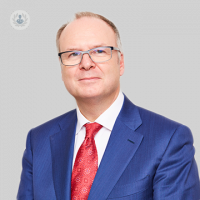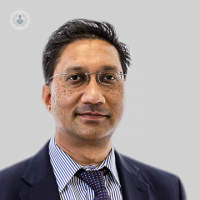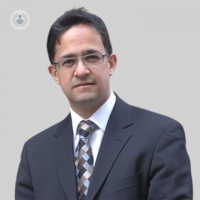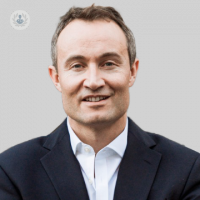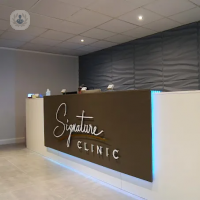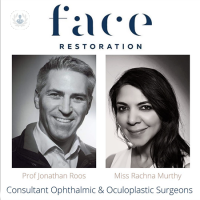What is blepharoplasty?
Blepharoplasty, or dark circles surgery, is a plastic surgery operation aimed at correcting eyelid defects and deformities, or to aesthetically modify the region around the eyes. It often involves the removal of excess skin, muscle, and fat that accumulates around the eyes with age, causing sagging and the appearance of bags under the eyes.

Why is blepharoplasty done?
As we get older, our skin loses its elasticity and the eyelids are no exception. As they stretch, creating excess skin, and the muscles that support them weaken, excess fat can start to collect above and below the eyelids, causing drooping eyebrows, upper eyelids and bags under the eyes.
If this excess fat and skin prevents your eyes from opening fully, it can interfere with your peripheral vision, meaning that blepharoplasty may be done to improve vision. However, most cases (particularly operations on the lower eyelids) are performed purely for cosmetic reasons, as the removal of bags and dark circles has the effect of rejuvenating the face.
What does blepharoplasty consist of?
There are two ways to perform this surgery:
External route: A small cut is made under the eyelashes, allowing the surgeon to remove excess skin, muscle and fat. It is then sealed by a very fine suture that facilitates skin tightening.
Internal route: A small incision is made in the inner part of the lower eyelid, through which fat is extracted. Some surgeons do not even use a suture to close the incision, since this tissue heals easily by itself. The eyes are protected by an orbital metallic strip, which is inserted after the patient is under anaesthesia (local or general, depending on whether the blepharoplasty is part of a longer procedure).
The duration of the surgery is usually between 30 minutes and one hour, depending on the number of eyelids that will be operated on.

Preparation for blepharoplasty
Before the blepharoplasty procedure, you will meet with an ophthalmologist and/or plastic surgeon, who will take your medical history and discuss your expectations with you. You will also have to undergo a physical examination, an eye test, and photos will be taken of your eye(s). Smokers will have to stop smoking several weeks before the operation.
Care after blepharoplasty
Once the surgery is completed, an ointment will be applied to the eyes to lubricate them and in some cases, a soft bandage.
Patients may experience blurred or double vision, excessive production of tears, hypersensitivity to light, discomfort or pain, and some swelling and bruising for a short while after a blepharoplasty.
Your doctor may suggest that you take steps such as sleeping with your head elevated higher than your chest for a few days and using cold compresses on your eyes in order to reduce inflammation and bruising.
You will be informed if you are required to apply eye drops to keep your eyes hydrated. Oedema and bruising will gradually diminish until it disappears completely and you will begin to look and feel much better.
11-13-2012 05-15-2023Blepharoplasty
Mr Simon Eccles - Plastic surgery
Created on: 11-13-2012
Updated on: 05-15-2023
Edited by: Carlota Pano
What is blepharoplasty?
Blepharoplasty, or dark circles surgery, is a plastic surgery operation aimed at correcting eyelid defects and deformities, or to aesthetically modify the region around the eyes. It often involves the removal of excess skin, muscle, and fat that accumulates around the eyes with age, causing sagging and the appearance of bags under the eyes.

Why is blepharoplasty done?
As we get older, our skin loses its elasticity and the eyelids are no exception. As they stretch, creating excess skin, and the muscles that support them weaken, excess fat can start to collect above and below the eyelids, causing drooping eyebrows, upper eyelids and bags under the eyes.
If this excess fat and skin prevents your eyes from opening fully, it can interfere with your peripheral vision, meaning that blepharoplasty may be done to improve vision. However, most cases (particularly operations on the lower eyelids) are performed purely for cosmetic reasons, as the removal of bags and dark circles has the effect of rejuvenating the face.
What does blepharoplasty consist of?
There are two ways to perform this surgery:
External route: A small cut is made under the eyelashes, allowing the surgeon to remove excess skin, muscle and fat. It is then sealed by a very fine suture that facilitates skin tightening.
Internal route: A small incision is made in the inner part of the lower eyelid, through which fat is extracted. Some surgeons do not even use a suture to close the incision, since this tissue heals easily by itself. The eyes are protected by an orbital metallic strip, which is inserted after the patient is under anaesthesia (local or general, depending on whether the blepharoplasty is part of a longer procedure).
The duration of the surgery is usually between 30 minutes and one hour, depending on the number of eyelids that will be operated on.

Preparation for blepharoplasty
Before the blepharoplasty procedure, you will meet with an ophthalmologist and/or plastic surgeon, who will take your medical history and discuss your expectations with you. You will also have to undergo a physical examination, an eye test, and photos will be taken of your eye(s). Smokers will have to stop smoking several weeks before the operation.
Care after blepharoplasty
Once the surgery is completed, an ointment will be applied to the eyes to lubricate them and in some cases, a soft bandage.
Patients may experience blurred or double vision, excessive production of tears, hypersensitivity to light, discomfort or pain, and some swelling and bruising for a short while after a blepharoplasty.
Your doctor may suggest that you take steps such as sleeping with your head elevated higher than your chest for a few days and using cold compresses on your eyes in order to reduce inflammation and bruising.
You will be informed if you are required to apply eye drops to keep your eyes hydrated. Oedema and bruising will gradually diminish until it disappears completely and you will begin to look and feel much better.


How is a symmetrical face achieved through surgery?
By Miss Katherine George
2024-10-31
Leading oral and maxillofacial surgeon and expert in correcting facial asymmetry, Miss Katherine George talks through the different options available to improve minor or major facial asymmetry and achieve a symmetrical face. See more
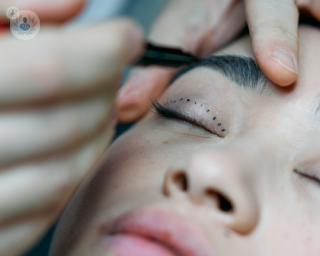

How safe is blepharoplasty surgery? Are there any associated risks?
By Miss Anuradha Jayaprakasam
2024-10-31
We recently spoke to Miss Anuradha Jayaprakasam, a highly experienced consultant ophthalmologist, who, here in this article below, discusses blepharoplasty surgery in detail, including how it is performed, and what recovery time entails. See more

What’s the difference between a plastic surgeon and an oculoplastic surgeon?
By Mr Daniel Ezra
2024-10-31
An oculoplastic surgeon is a specialised ophthalmologist who has chosen to specialise in both eyelid & facial plastic surgery relevant to the eyes. Mr Daniel Ezra, expert oculoplastic surgeon, explains what types of surgery he is able to perform, and the advantages of oculoplastic surgery. See more


Refresh and rejuvenate: Effective treatment for swollen and puffy under eye bags
By Mr Daniel Ezra
2024-10-31
Puffy under eye bags or folds in the skin below the eye, also known as malar bags and festoons, can be effectively treated to help to correct the signs of ageing. Leading consultant ophthalmic and oculoplastic surgeon Mr Daniel Ezra gives an expert guide to the available treatment options in the illuminating article. See more
Experts in Blepharoplasty
-
Mr Jimmy Uddin
OphthalmologyExpert in:
- Thyroid eye disease
- Blepharoplasty
- Oculoplastics
- Watery eyes
- Chalazion
- Eyelid cancer
-
Mr Simon Eccles
Plastic surgeryExpert in:
- Facelift
- Facial reconstruction
- Children's plastic surgery
- Blepharoplasty
- Rhinoplasty (nose job)
- Body contouring
-
Dr Julian De Silva
Plastic surgeryExpert in:
- Blepharoplasty
- Oculo-facial plastic and cosmetic surgery
- Facelift
- Rhinoplasty (nose job)
- Dermal fillers
- Neck lift
-
Mr Jonathan Britto
Plastic surgeryExpert in:
- Blepharoplasty
- Facelift
- Facial paralysis
- Mid face lift
- Facial plastic surgery
- Rhinoplasty (nose job)
-
Mr Richard Scawn
OphthalmologyExpert in:
- Oculoplastics
- Blepharoplasty
- Ptosis (droopy eye)
- Watery eyes
- Chalazion
- Blepharitis
- See all

Signature Clinic Manchester
Signature Clinic Manchester
93A Manchester Rd, Rochdale
No existe teléfono en el centro.
By using the telephone number provided by TOP DOCTORS, you automatically agree to let us use your phone number for statistical and commercial purposes. For further information, read our Privacy Policy
Top Doctors

Face Restoration
Face Restoration
Phoenix Hospital Group, 9 & 25 Harley St, London W1G 9QY
No existe teléfono en el centro.
By using the telephone number provided by TOP DOCTORS, you automatically agree to let us use your phone number for statistical and commercial purposes. For further information, read our Privacy Policy
Top Doctors

The Chiltern Hospital - part of Circle Health Group
The Chiltern Hospital - part of Circle Health Group
London Rd, Great Missenden HP16 0EN
No existe teléfono en el centro.
By using the telephone number provided by TOP DOCTORS, you automatically agree to let us use your phone number for statistical and commercial purposes. For further information, read our Privacy Policy
Top Doctors
-
Signature Clinic Manchester
93A Manchester Rd, Rochdale, ManchesterExpert in:
- Abdominoplasty
- Blepharoplasty
- Facelift
- Cosmetic gynaecology
- Gynaecomastia
- Liposuction
-
Face Restoration
Phoenix Hospital Group, 9 & 25 Harley St, London W1G 9QY, W1G Marylebone LondonExpert in:
- Blepharoplasty
- Eyelid surgery
- Facial aesthetics
- Laser
- Skin rejuvenation
- Dermal fillers
-
The Chiltern Hospital - part of Circle Health Group
London Rd, Great Missenden HP16 0EN, Great MissendenExpert in:
- Allergies Ophthalmological
- Clinical analysis
- Cancer
- Breast Cancer
- Skin Cancer
- Prostate Cancer
- Most viewed diseases, medical tests, and treatments
- Polynucleotides
- Endovenous laser treatment (EVLA)
- Minimal access surgery (keyhole surgery)
- Head and neck cancer
- Neck lump
- Acellular dermal matrix (ADM)
- Prepectoral breast reconstruction
- Vaginal dryness
- One Stop Breast Clinic
- Botulinum toxin (Botox™)
